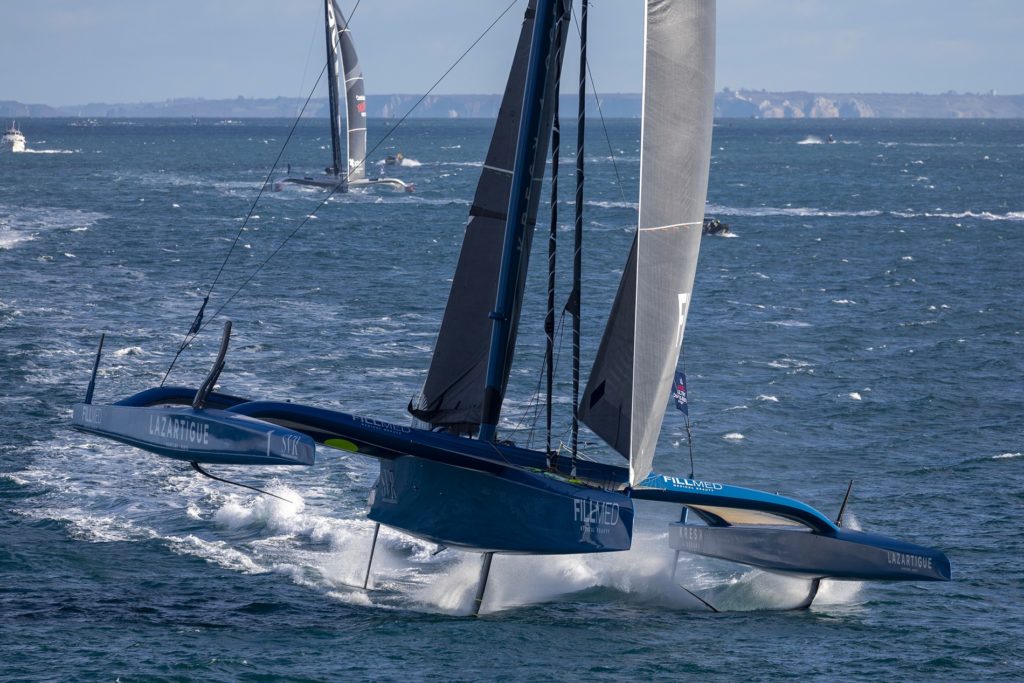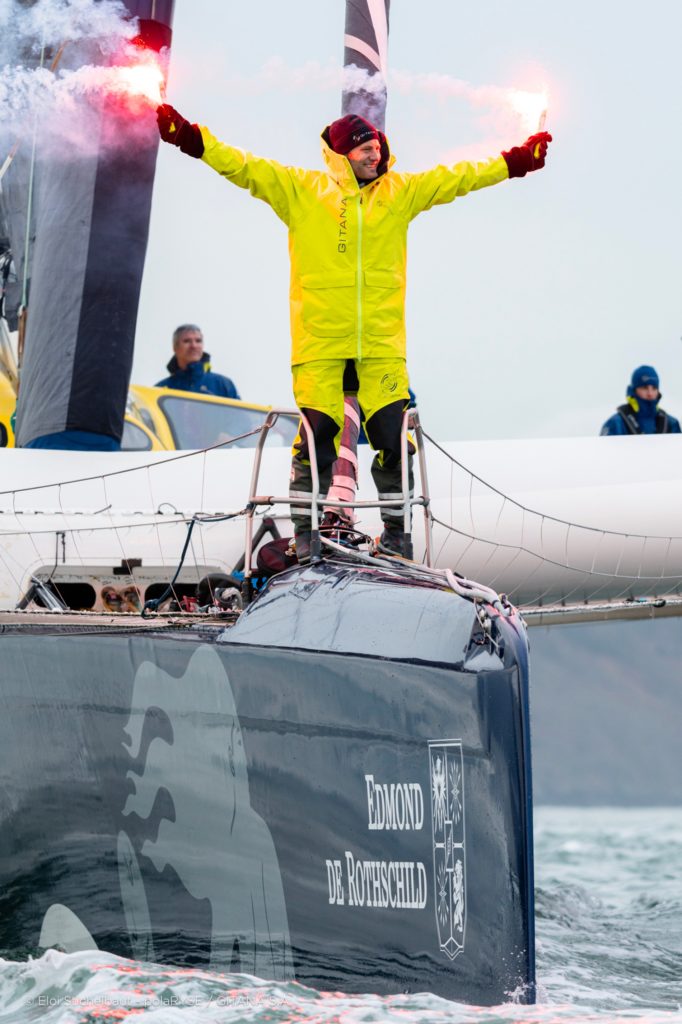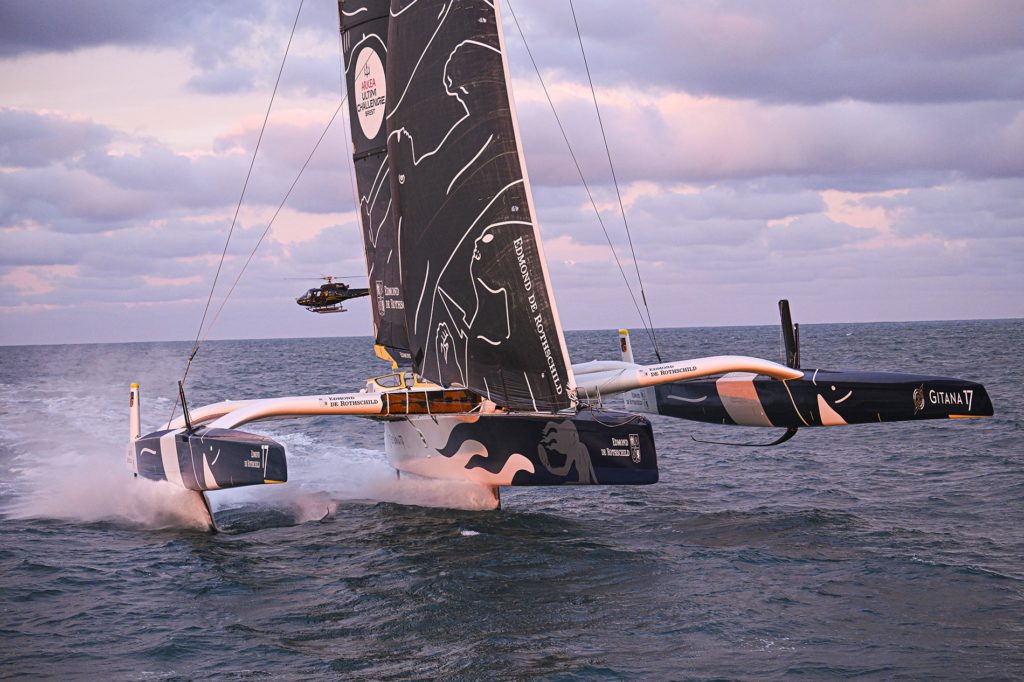Text: Patricia Oudit
More than just a race, the Arkea Ultim Challenge, the first single-handed round-the-world race on giant trimarans, was an adventure, an expedition of pioneers committing themselves body and soul to the unknown. Here’s the story.
On Tuesday, February 27, at 8 h, 37 min and 42 s, in crowded Brest, under a gray sky, the man in the yellow foulies had a banana glued to his lips. After 50 days, 19 hours, 7 minutes and 42 seconds at sea, Charles Caudrelier at the helm of Maxi Edmond de Rothschild set foot on land to the sound of Queen’s Don’t stop me now, the song he had chosen for his arrival. However, the man stopped twice to dodge the storms. He first waited several days off Cape Horn, after thirty days of racing, then stopped in the Azores on the final stretch. This will be the first time that a Formula 1 ocean race has been won on flying boats measuring 32 m long by 23 m wide and capable of speeds of up to 50 knots. If the Finistère native, who celebrated his 50th birthday the day before, took five days longer than planned to cover the 40,000 kilometers from west to east via the Capes of Good Hope (South Africa), Leeuwin (Australia) and Horn (Chile), it’s because he used the subtle balance between conservatism and risk-taking that makes great strategists.

Serial damage
Experience has paid off, and time has spoken here too: Caudrelier had the luxury of waiting until he was 30 to enter the club of the greats, winning the Solitaire du Figaro in 2004, then making up for lost time with a string of victories (2011-2012 and 2017-2018 editions of the Volvo Ocean Race), before joining the Gitana stable in 2019, owned by the Rothschild family of Swiss bankers, founded in 2000. On this race, the winner of the Route du Rhum 2022 played the master of the clocks. At first, he went fast, racing almost side-by-side with 26-year-old Tom Laperche, then widened the gap by playing for time, after the race’s youngest competitor was unlucky: on January 17, skipper SVR Lazartigue damaged his central hull when he hit a UFO. Final pit stop. It’s worth noting that damage was the final judge of the race. Armel Le Cléac’h on Maxi Banque Populaire XI had to take a break in Recife (Brazil) to repair a foil, a headsail and his balcony; Anthony Marchand on Actual 3 suffered serious damage to his foils; Éric Péron on Adagio damaged his starboard rudder and steering system. Last but not least, Thomas Coville on Sodebo 3 had to pit-stop in Hobart (Tasmania) due to a partially torn-off front balcony on the central hull. Meanwhile, the skipper of the Gitana stable was at one with his giant trimaran, becoming, in his own words, “a machine, a robot connected to performance, a kind of killer who doesn’t let go of a nautical mile”.

Legs in the air
A race won from start to finish does not mean a race won in advance or a quiet river. Although he set the single-handed, multihull Indian Ocean record (8 days and 8 hours), the sailor was not spared by weather that sometimes made the ocean look like a minefield, nor did it spare his boat. Dealing with a breach in his front fairing on day 4 of the race, having to take 10 hours to repair a mainsail torn in two after Cape Horn, not to mention moments of fear. The first, in the Deep South, when a wave made a 2 m by 1 m hole in his cockpit from which the skipper could see the water. “I’m so used to going that way that one time I forgot about the hole, and I ended up with my legs in the air, catching myself by the arms at one end,” he recounts. Another big scare came in the middle of the doldrums (inter-tropical convergence zone where flat calm alternates with squalls), when he was dozing in a violent squall that flattened his trimaran. A rude awakening “at 41 degrees, on the verge of capsizing”, recalls the winner. Last but not least, his arm was damaged by a wind turbine, an incident that could have gone very badly. Luck smiled on the daring man, who, like the other participants, didn’t know what to expect.


Forever the first
For example, Éric Péron, on Adagio, the only non-flying boat in the fleet, told us at the start from Brest on January 7: “It’s more of an adventure than a race, and we don’t know who’ll be able to finish it…”. Who would have predicted that Péron would go faster than the winner in the Pacific? Who would have bet on Charles Caudrelier’s impeccable record, hailed by his rivals? Who could have certified that these jewels of technology, which have shrunk the planet, where people sleep with one eye open for 20 minutes at a time, where the slightest maneuver takes 4 to 5 times longer than normal in an incessant noise, where cha- viring is not an option, could sail for 50 days and more, technical breakdown included? It’s an inordinate challenge that not only amoche the boats, but also “makes the men go down in history”, as Thomas Coville, second in the race, summed up, moved to tears, when he arrived 2 days later in 53 days 1 hour 12 minutes and 40 seconds, after a complicated ascent of the Bay of Biscay. Coville, 55, a pioneer of the category if ever there was one, was signing his 9th circumnavigation, his 7th in a multihull, his 5th solo, an absolute record on this type of boat. He knows better than anyone the faith it takes to complete a circumnavigation like this. “Surpassing yourself is not enough. We’ll be looking for some pain, some self-sacrifice, some discovery…”, said the skipper of Sodebo 3 at the start. An expedition that only seven multihull racers before Caudrelier have completed in record mode. Infinitely fewer than there have been men on the moon. In 1973, the late Alain Colas, who died at sea, completed his solo circumnavigation in 169 days. Charles Caudrelier took 119 days less. Never mind the statistics. Let’s remember that Caudrelier, Coville, Le Cléac’h 3rd, Anthony Marchand and Éric Péron will forever be at the top of the class (Ultim). See you in 4 years. Others will join them. This time, nothing will stop them.

